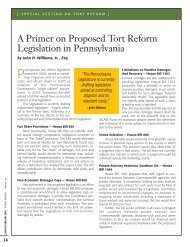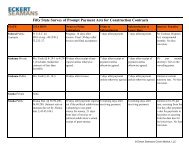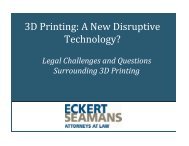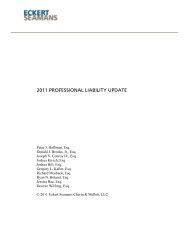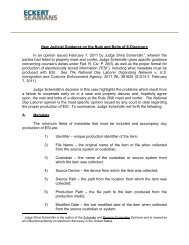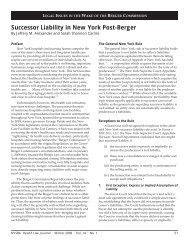where payment is made by Medicaid would lead to an inequity because patients paying formedical services privately would be treated differently than patients paying with Medicaid.Ultimately, the court concluded the Medicaid regulations in question “do not impose a legalstandard relevant to an action for lack of informed consent.”The Isaac court’s narrow holding does not completely foreclose the possibility that someMedicaid regulations may be relevant to the legal standard for informed consent claims. Also,the court noted their decision did not address whether the specific Medicaid regulations at issuewere relevant in support of a cause of action for negligence regarding the quality of informationprovided by a doctor when obtaining informed consent.The Supreme Court of Pennsylvania recently addressed whether the substantial factorelement of an informed consent claim may be established solely through the testimony of thepatient’s spouse. 2 See Fitzpatrick v. Natter, 599 Pa. 465, 961 A.2d 1229 (2008). In Fitzpatrick,The court held that the testimony of a patient’s spouse may be sufficient to prove the substantialfactor element. 3 Id.The evidence at trial revealed that Carol Fitzpatrick, appellant, was diagnosed withmultiple sclerosis (“MS”) when she was nineteen years old, in or around 1972. In 1998 Carolbecame a patient of Dr. Natter, a neurologist. By 1998, Carol was having difficulty walking, hadincontinence, intermittent pain, and other symptoms. Rather than continue taking oral doses ofan anti-spasticity drug, Dr. Natter suggested that Carol undergo surgery to have a subcutaneouspump implanted that would administer the drug uniformly and continuously. Dr. Natterprovided Carol with information on the pump, which included the risks and benefits associatedwith it, and referred Carol to appellee, Dr. Munz. Carol opted for surgery.Subsequent to the surgery Carol’s condition deteriorated drastically until she becameparaplegic, incontinent, and wholly dependent upon her husband, Thomas. In 2002, Carol andThomas filed a professional liability action alleging breach of standard of care, battery or lack ofinformed consent, and loss of consortium.A jury trial commenced in 2004 limited to the claims of lack of informed consent andloss of consortium. At trial, Thomas testified that he and his wife, Carol, made all medicaldecisions jointly and that, had all risks associated with Carol’s surgery been fully disclosed,Carol would have opted against surgery. According to the findings of the Court, Plaintiffs madethe strategic decision for Carol not to testify, although she was present in the courtroom for mostproceedings. In March 2004, the jury returned a verdict for Plaintiffs finding, in part, thatappellee failed to obtain Carol’s informed consent before performing the pump implantationsurgery and that information he failed to provide would have been a substantial factor in Carol’sdecision to undergo the surgery.2 In this case, the patient was present during most courtroom proceedings and was able to testify on her own behalfbut the decision was made for her to not testify.3 It should be noted that the court, in reaching its decision, interpreted informed consent statute 40 Pa. Cons. Stat.§1301.811-A, which has been repealed in favor of 40 Pa. Cons. Stat. § 1303.504, although the court did note that thestatutes are materially similar for the purposes of its decision.54
Appellee filed post-trial motions for a new trial and judgment notwithstanding theverdict. The trial court granted the motion for judgment notwithstanding the verdict, finding thatPlaintiffs’ informed consent claim failed as a matter of law. Specifically, the trial court foundthat Plaintiffs’ claim failed because the informed consent statute required the patient herself totestify that the allegedly undisclosed information would have been a substantial factor in herdecision making. The trial court reasoned that without Carol’s testimony, the jury could onlyspeculate as to what her thought process was and whether she had, in fact, provided informedconsent to the surgery.Appellants appealed the decision of the trial court to the Superior Court, which affirmedthe grant of judgment notwithstanding the verdict in an unpublished opinion. The SuperiorCourt panel determined that Thomas’ testimony was insufficient to prove that the allegedlyundisclosed information would have been a substantial factor in Carol’s decision making. Thepanel reasoned that although Thomas could testify as to what he understood the risks of thesurgery to be, or what he suggested to Carol regarding the risks, he could not testify about thesignificance Carol may have placed on the allegedly missing information.The primary issue before the Supreme Court was whether the testimony of a person otherthan the patient can be sufficient to prove the substantial factor element. The Supreme Courtheld that, “as in other areas of the law, circumstantial or indirect evidence may suffice for aninformed consent patient to prove the elements of her claim.” Fitzpatrick, 961 A.2d at 1241.Thus, “a patient’s decision to refrain from testifying at trial is not fatal to the claim.” Id.E. Hospital Liability1. Theories of Hospital LiabilityHistorically, Pennsylvania hospitals were immune from tort liability based on thedoctrine of charitable immunity. Benedict v. Bondi, 122 A.2d 209 (Pa 1956). In 1965, however,the Pennsylvania Supreme Court abolished the doctrine of charitable immunity, therebyeliminating the hospital’s shield to liability. Flagiello v. Pa. Hosp., 208 A.2d 193 (Pa. 1965).Today, Pennsylvania courts may impose liability on hospitals based on any one of three theories.(a)Respondeat Superior – General Principles and Recent CasesUnder the doctrine of respondeat superior, an employer may be held vicariously liablefor the negligent acts of its employees if the acts were committed during the course of and withinthe scope of the employment.In Tonsic v. Wagner, 329 A.2d. 497 (Pa. 1974), the Pennsylvania Supreme Court held forthe first time that agency principles should also apply to operating physicians as well ashospitals. Because the hospital’s liability is based on principles of agency law, a Plaintiff mustshow the existence of a master-servant relationship between the negligent staff member and thehospital.Generally, a master-servant relationship will be found where the hospital not onlycontrols the result of the work but has the right to direct the manner in which the work shall be55
- Page 3 and 4:
EMTALA CASES ......................
- Page 5:
Filing an Affidavit of Non-Involvem
- Page 8 and 9:
II.PROFESSIONAL LIABILITY - AN OVER
- Page 10 and 11: The Superior Court reversed the tri
- Page 12 and 13: to a third party pursuant to the st
- Page 14 and 15: After approximately five months, De
- Page 16 and 17: learned the day after the surgery t
- Page 18 and 19: conduct to the delay in colon cance
- Page 20 and 21: court admitted the expert’s testi
- Page 22 and 23: (b)(c)other reasonable causes, incl
- Page 24 and 25: corroborated his testimony. The cou
- Page 26 and 27: husband’s estate. Plaintiff alleg
- Page 28 and 29: Other notable federal cases arising
- Page 30 and 31: The Superior Court found that in re
- Page 32 and 33: § 1303.512(b). The court, however,
- Page 34 and 35: In Neidig v. United States, No. 07-
- Page 36 and 37: Additionally, the Supreme Court not
- Page 38 and 39: were not indicated for her conditio
- Page 40 and 41: surgeon is the same as it would be
- Page 42 and 43: It should be noted that the Superio
- Page 44 and 45: Finally, the court held that the tr
- Page 46 and 47: The Supreme Court of Pennsylvania r
- Page 48 and 49: nurses deviating from applicable st
- Page 50 and 51: certainty, the court reviews expert
- Page 52 and 53: Under Pennsylvania law, the Court n
- Page 54 and 55: testimony, Defendant presented his
- Page 56 and 57: Following Cooper v. Roberts, 286 A.
- Page 58 and 59: Plaintiff developed chronic diarrhe
- Page 62 and 63: accomplished. In Valles v. Albert E
- Page 64 and 65: In 1980, the Pennsylvania Superior
- Page 66 and 67: Plaintiff had a routine monitoring
- Page 68 and 69: Plaintiff’s Contract ClaimsThe Co
- Page 70 and 71: is a failure to report changes in a
- Page 72 and 73: unit to assure post-surgical patien
- Page 74 and 75: sliced his wrist and arm with a raz
- Page 76 and 77: licensed professionals for whom the
- Page 78 and 79: (c)Limitations of Corporate Neglige
- Page 80 and 81: Even more recently, our Superior Co
- Page 82 and 83: (a)HMO IssuesIn McClellan v. Health
- Page 84 and 85: affidavit submitted by Defendants o
- Page 86 and 87: treatments while at VA’s faciliti
- Page 88 and 89: [s]ubstantively, we believe that a
- Page 90 and 91: The party claiming the benefit of t
- Page 92 and 93: deprive (him) of civil rights guara
- Page 94 and 95: found that the District Court was w
- Page 96 and 97: With respect to fraudulent concealm
- Page 98 and 99: would be applied in situations wher
- Page 100 and 101: they had not raised them in the cou
- Page 102 and 103: (a)Informed ConsentUnder MCARE, a p
- Page 104 and 105: civil enforcement provisions and ma
- Page 106 and 107: MCARE also changes the manner in wh
- Page 108 and 109: whose death, in 2005, was allegedly
- Page 110 and 111:
vicariously liable if the plaintiff
- Page 112 and 113:
health center or its equivalent or
- Page 114 and 115:
In Pennsylvania Medical Society, th
- Page 116 and 117:
to any professional who is alleged
- Page 118 and 119:
Since the 2005 amendments, there ha
- Page 120 and 121:
ule, but who intentionally ignores
- Page 122 and 123:
the original Complaint was delivere
- Page 124 and 125:
foreclose all challenges against th
- Page 126 and 127:
number of boxes), which was support
- Page 128 and 129:
questions of professional judgment
- Page 130 and 131:
deviated from any professional stan
- Page 132 and 133:
The Third Circuit affirmed the Dist
- Page 134 and 135:
claims and cross-claims remain agai
- Page 136 and 137:
By an Amendatory Order dated March
- Page 138 and 139:
The court acknowledged that there i
- Page 140 and 141:
apply and that the trial court misa
- Page 142 and 143:
Barbados had enough litigation-spec
- Page 144 and 145:
E. Preemption of Vaccine Design Def
- Page 146 and 147:
2. Pa. R. Civ. Pro. 1036.1 - Reinst
- Page 148 and 149:
Barrick, at *34-35.Furthermore, the
- Page 150 and 151:
(b) the utility of the defendant’
- Page 152 and 153:
2006). In this case, Plaintiffs bro
- Page 154 and 155:
B. Elements of a Cause of Action fo
- Page 156 and 157:
decision in Muhammad precluded Mr.
- Page 158 and 159:
considered speculative “only if t
- Page 160 and 161:
underlying cause of action involved
- Page 162 and 163:
In Capital Care Corp., the Superior
- Page 164 and 165:
The court found, however, to state
- Page 166 and 167:
of reasonable diligence. The standa
- Page 168 and 169:
not be set aside. On July 7, 2005,
- Page 170 and 171:
complete bar to recovery. Since a l
- Page 172 and 173:
On appeal, Plaintiffs claimed that
- Page 174 and 175:
In Liggon-Redding, 659 F.3d at 265,
- Page 176 and 177:
elieved of those minimum standards
- Page 178 and 179:
elevant to the proceedings, the com
- Page 180 and 181:
establish professional misconduct b
- Page 182 and 183:
Upholding the Superior Court’s Or
- Page 184 and 185:
Id.Rejecting revocation and suspens
- Page 186 and 187:
order as a sanction under Rule 4019
- Page 188:
{1009912]182




